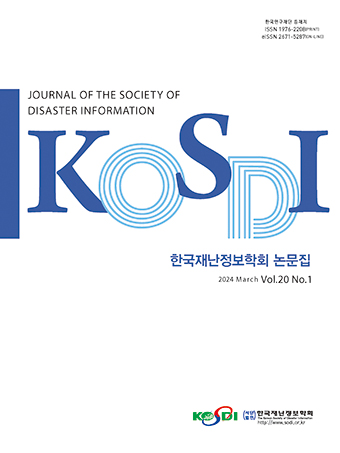Original Article
Abstract
References
Information
Purpose: The purpose of this study is to evaluate the fire srpead risk of building exterior and roofing materials due to the firebrand of forest fire occurring in the urban areas. Method: In order to achieve this research purpose, by selecting building materials used for exterior and roofing materials of buildings, the time to ignition, total heat release, and heat release rate were investigated, and a forest fire firebrand system was established to the possibility of fire spread was confirmed. Result: As a result of the cone calorimeter test, the roofing material had a similar or faster ignition time due to radiant heat compared to the exterior material with the steel plate exposed to the outside, and showed a higher heat release rate and total heat release than the exterior material. Although it was affected by the flammable material, it was confirmed that it did not spread easily due to the limited amount of combustible material, and carbonization marks appeared inside. Conclusion: The cone calorimeter test method has been shown to be useful in understanding the combustion characteristics of building materials by radiant heat, but the fire spread due to a firebrand in a forest fire is directly affected by the flame due to the ignition of surrounding combustibles, so finding a direct correlation with the cone calorimeter method is difficult. It is judged that the roof material may be more vulnerable to the spread of fire due to the fire than the exterior material.
연구목적: 본 연구는 도심지 인접에서 발생하는 산불의 불티로 인한 건축물 외장재 및 지붕재의 화재확산 위험성 평가를 목적으로 한다. 연구방법: 이러한 연구목적을 달성하기 위해서 건축물의 외장재와 지붕재로 사용되는 건축자재를 선별하여 착화시간, 총 방출열량, 열방출률을 확인하고 산불 불티 비화 시스템을 구축하여 산불 불티로 인한 각각의 재료에 대한 화재 확산 가능성을 확인하였다. 연구결과: 콘칼로리미터 실험결과 지붕재는 철판이 외부에 노출된 외장재에 비해 복사열로 인한 착화시간이 비슷하거나 빨랐으며 외장재보다 높은 열방출률과 총 방출열량을 나타냈으며, 불티 비화 실험에서 외장재는 하부에 가연물이 착화함에 따라 영향을 받았으나 제한된 가연물의 양으로 쉽게 확산하지 않고 내부에서 탄화흔이 나타난 것을 확인할 수 있었으나 지붕재의 경우 사용 재료에 따라 불티로 인한 가연물 착화로 쉽게 녹고 주변으로의 확산에 기여하는 것을 확인할 수 있었다. 결론: 콘칼로리미터 실험 방법은 복사열로 건축자재의 연소 특성을 파악하는데 유용한 것으로 나타났으나 산불에서 불티로 인한 화재확산은 주변 가연물의 착화로 직접 화염에 영향을 받아 콘칼로리미터 방법과 직접적인 연관성을 찾는 것은 어려움이 있고 외장재에 비해 지붕재가 불티로 인한 화재 확산에 더 취약할 수 있는 것으로 판단된다.
- Chae, J.-S., Kim, B.-K., Lee, J.-H., Lee, S.-Y. (2019). "A study on mitigation of facilities damage caused by forest fire." Journal of the Korean Society for Wellness, Vol. 14, No. 3, pp. 39-51. 10.21097/ksw.2019.08.14.3.39
- ISO 5660-1:2015 (2015). Reaction-to-fire tests - Heat release, smoke production and mass loss rate - Part 1: Heat release rate (cone calorimeter method) and smoke production rate (dynamic measurement), International Standard Organization, Switzerland.
- Korea Forest Service (2016). 2016 Forest Basic Statistics, Korea.
- Korea Forest Service (2021). 2020 Statiscial Yearbook of Forestry Fire, Korea.
- Yeom, C.-H., Lee, S.-Y., Kwon, C.-H., Park, H.-S. (2015). "Analysis of the characteristics of the behaviour and damaged facilities of Pohang forest fires." Crisisonomy, Vol. 11, No. 1, pp. 115-130.
- Yeom, C., Lee, S.-Y., Park, H., Kwon, C.-H. (2019). "A study on facilities damage characteristics caused by forest fire in Goseong-Gun." Journal of the Society of Disaster Information, Vol. 15, No. 4, pp. 469-478.
- Publisher :The Korean Society of Disaster Information
- Publisher(Ko) :한국재난정보학회
- Journal Title :Journal of the Society of Disaster Information
- Journal Title(Ko) :한국재난정보학회논문집
- Volume : 17
- No :3
- Pages :617-626
- DOI :https://doi.org/10.15683/kosdi.2021.9.30.617




 Journal of the Society of Disaster Information
Journal of the Society of Disaster Information







